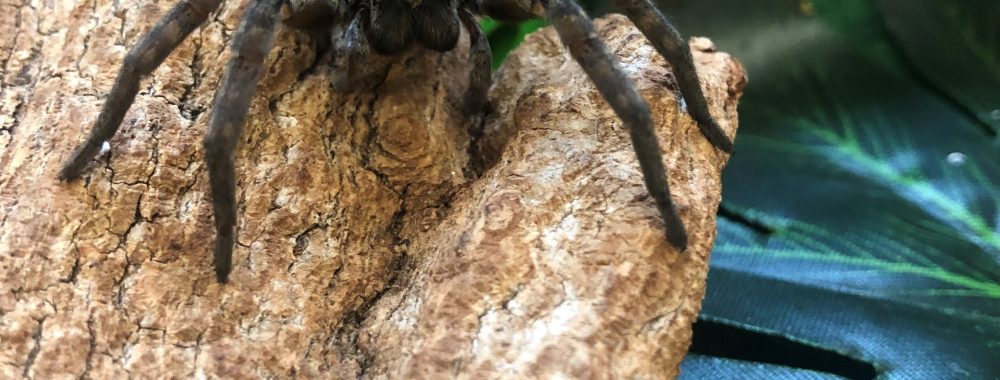Charlie
Fast Facts
- Family: Theraphosidae
- Order: Araneae
- Phylum: Arthropoda
- Genus/Species: Grammostola pulchripes

Lifespan
Males average 5-6 years, while females can live much longer – over 20 years in captivity. Little is known about how long they might live in the wild.
Natural Habitat
Native to the Chaco region of South America including parts of Argentina, Bolivia, Uruguay, Paraguay and Brazil with a climate of warm dry winters and wet summers. They are ground-dwelling in the grasslands and are a burrowing species.
Features
Black or dark brown in color with yellow (or gold) markings over the “knee” joints, this is one of the larger and most docile species of tarantula. Known to be gentle and tolerant, the Chaco Golden Knee can grow up to 20-22 cm (up to 7-9 inches!) legspan. After mating the female lays 100-500 eggs in a silk capsule, which then hatch 6 weeks later as spiderlings. Tarantulas, like other spiders, have an external skeleton (exoskeleton) that protects and supports their bodies.
Diet
They eat insects and other invertebrates and arthropods after injecting digestive juices through their two hollow fangs into the prey and then sucking up the liquified contents. Charlie is fed mealworms, dubia roaches and crickets.
Conservation
Spiders play an important role in the food chain helping to control populations of insects. Luckily, this species is considered of “least concern” by the IUCN (International Union for Conservation of Nature).
Fun Facts
- Tarantulas have a special adaptation for defense called “urticating” hairs which are on the sides and back of the abdomen and can be released or flung if they are stressed. These blond hairs are extremely irritating and itchy to the nose, mouth and eyes of would-be predators.
- They can spin silk, but unlike other spiders, they do not use it to spin webs to catch prey (which they instead hunt for, pounce on, grab with their pedipalps (front limbs), then spear with their fangs and inject with venom to paralyze and kill). They use the silk to line their burrows and protect their eggs.
- Tarantula venom is rarely toxic to humans and no person has actually ever died from a tarantula bite.
- The tarantula’s exoskeleton does not grow. Instead, as she grows, she must molt, or shed, the exoskeleton. This process may take over 24 hours and happens with the spider laying upside down while she then literally drops out of her skin!
- Like all spiders, tarantulas are arachnids (not insects) thus having 8 legs (instead of 6).
- Baby tarantulas are called spiderlings or “slings” for short.
- Tarantulas like to live alone. If housed together, you will sooner than later likely only find one, as cannibalism will likely occur!
- They live in burrows that may be self-made or those abandoned by rodents or lizards, usually hidden under rocks or logs.


We love meeting new people!